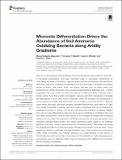Por favor, use este identificador para citar o enlazar a este item:
http://hdl.handle.net/10261/343045COMPARTIR / EXPORTAR:
 SHARE SHARE
 CORE
BASE CORE
BASE
|
|
| Visualizar otros formatos: MARC | Dublin Core | RDF | ORE | MODS | METS | DIDL | DATACITE | |

| Título: | Microsite differentiation drives the abundance of soil ammonia oxidizing bacteria along aridity gradients |
Autor: | Delgado-Baquerizo, Manuel CSIC ORCID ; Maestre, Fernando T.; Eldridge, David J.; Singh, Brajesh K. | Fecha de publicación: | abr-2016 | Editor: | Frontiers Media | Citación: | Frontiers in Microbiology 7: 505 (2016) | Resumen: | Soil ammonia oxidizing bacteria (AOB) and archaea (AOA) are responsible for nitrification in terrestrial ecosystems, and play important roles in ecosystem functioning by modulating the rates of N losses to ground water and the atmosphere. Vascular plants have been shown to modulate the abundance of AOA and AOB in drylands, the largest biome on Earth. Like plants, biotic and abiotic features such as insect nests and biological soil crusts (biocrusts) have unique biogeochemical attributes (e.g., nutrient availability) that may modify the local abundance of AOA and AOB. However, little is known about how these biotic and abiotic features and their interactions modulate the abundance of AOA and AOB in drylands. Here, we evaluate the abundance of amoA genes from AOB and AOA within six microsites commonly found in drylands (open areas, biocrusts, ant nests, grasses, nitrogen-fixing shrubs, and trees) at 21 sites from eastern Australia, including arid and mesic ecosystems that are threatened by predicted increases in aridity. Our results from structural equation modeling suggest that soil microsite differentiation alters the abundance of AOB (but not AOA) in both arid and mesic ecosystems. While the abundance of AOA sharply increased with increasing aridity in all microsites, the response of AOB abundance was microsite-dependent, with increases (nitrogen-fixing shrubs, ant nests), decreases (open areas) or no changes (grasses, biocrusts, trees) in abundance with increasing aridity. Microsites supporting the highest abundance of AOB were trees, nitrogen-fixing shrubs, and ant nests. These results are linked to particular soil characteristics (e.g., total carbon and ammonium) under these microsites. Our findings advance our understanding of key drivers of functionally important microbial communities and N availability in highly heterogeneous ecosystems such as drylands, which may be obscured when different soil microsites are not explicitly considered. | Descripción: | 12 páginas.- 5 figuras.- referencias.- The Supplementary Material for this article can be found online at: http://journal.frontiersin.org/article/10.3389/fpls.2016.00990 | Versión del editor: | http://hdl.handle.net/10.3389/fpls.2016.00990 | URI: | http://hdl.handle.net/10261/343045 | DOI: | 10.3389/fmicb.2016.00505 | E-ISSN: | 1664-302X |
| Aparece en las colecciones: | (IRNAS) Artículos |
Ficheros en este ítem:
| Fichero | Descripción | Tamaño | Formato | |
|---|---|---|---|---|
| fmicb-07-00505.pdf | 1,48 MB | Adobe PDF |  Visualizar/Abrir |
CORE Recommender
PubMed Central
Citations
7
checked on 03-may-2024
SCOPUSTM
Citations
23
checked on 11-may-2024
WEB OF SCIENCETM
Citations
18
checked on 22-feb-2024
Page view(s)
11
checked on 16-may-2024
Download(s)
4
checked on 16-may-2024

